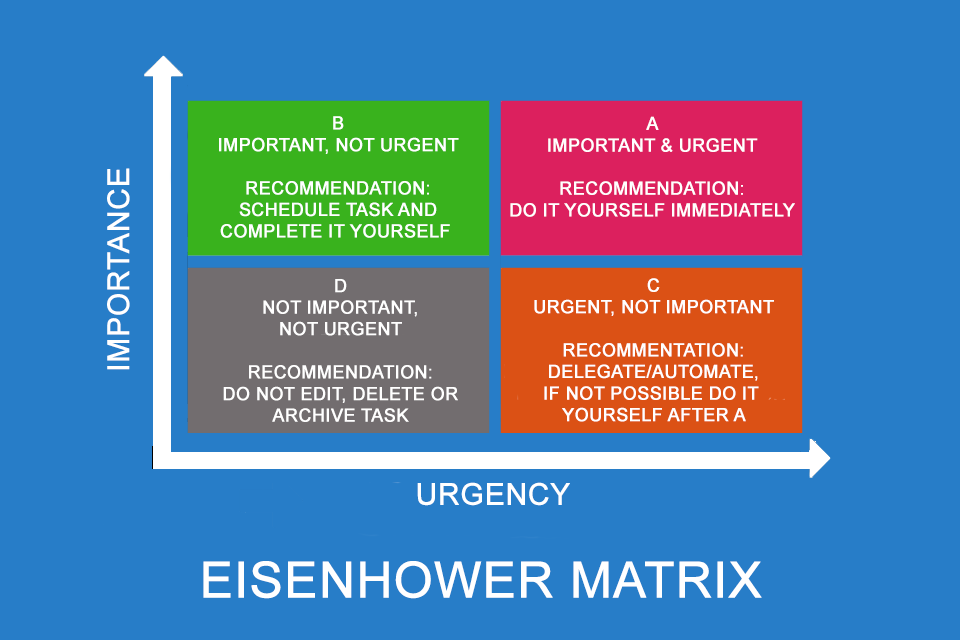What is the Eisenhower Matrix?
Smartpedia: The Eisenhower Matrix helps to distinguish between important and unimportant, urgent and non-urgent tasks. It is a method for prioritising tasks.
Eisenhower Matrix Definition
The Eisenhower Matrix is a method of time management to distinguish between important and unimportant, urgent and non-urgent tasks. Alternatively, it is also known as the four-quadrant method, Eisenhower method, Eisenhower principle or Eisenhower Box.
The method is named after Dwight D. Eisenhower, the 34th US president (1953 – 1961). In a speech to the World Council of Churches on 19 August 1954, he quoted a former college president, not mentioned by name, as follows
“I have two kinds of problems, the urgent and the important. The urgent are not important, and the important are never urgent”.¹
Incidentally, it is not proven whether Dwight D. Eisenhower practised the prioritisation method himself.
Aim of the Eisenhower Matrix
The aim of the Eisenhower Matrix is to sort and prioritise tasks according to their importance and urgency. It is about “not doing things right, but doing the right things”. It is therefore a tool for increasing effectiveness (“doing the right things”) and not a tool for increasing efficiency (“doing things right”).
In order to sort and prioritise tasks, two questions per task must be answered:
- How important is the task?
- How urgent is the task?
To answer the questions, the matrix defines four categories:
- A: important and urgent
- B: important, but not urgent
- C: urgent, but not important
- D: not important and not urgent
Principles of the Eisenhower Matrix
The principles of the the Eisenhower Matrix are relatively simple:
- Important tasks are those that are directly related to defined goals.
- Urgent tasks cannot be postponed and should ideally be completed immediately.
- Important and urgent tasks should be completed by yourself as quickly as possible.
- Urgent, but not important tasks should – if possible – be delegated or automated. If this is not possible, they should be completed after the urgent and important tasks and before the important and non-urgent tasks.
- The personal realisation of important but non-urgent tasks can be planned and scheduled. The tasks themselves are prioritised lower than the important and urgent tasks, so that the realisation only takes place afterwards.
- Non-important and non-urgent tasks should not be processed. Depending on the context, they can be archived or completely deleted.
The Eisenhower Principle does not require any prior knowledge of the application. Separate tools – in addition to a sheet of paper and a pen – are also not required. The ideal result would be lists of tasks that have to be completed immediately, that can be planned, that should be delegated and that can be easily ignored or deleted.
Advantages of the Eisenhower Matrix
The Eisenhower principle offers several advantages:
- It is easy to understand and use. It does not require any special previous knowledge and no training period.
- The division of tasks into the four categories can usually be completed quickly. In addition, time hogs – non-important and non-urgent tasks – are easy to identify.
- This principle helps to keep an eye on strategically important and urgent tasks.
- Separate tools – apart from a sheet of paper and a pen – are not necessary. Ideally, the result is a list of tasks that need to be completed immediately, that can be planned, that should be delegated and that can simply be ignored or deleted.
- The sorting can easily be supplemented with additional information such as a due date.
- The visualisation is simple, creates order and provides a clear structure for the completion of tasks.
Sometimes the visualisation is also mentioned as a point of criticism because it quickly becomes confusing when a large number of tasks are involved. However, this argument negates that the matrix essentially wants to convey the idea behind the method. In practice, the collection, sorting and prioritisation of tasks should be done in lists.
In theory, the Eisenhower principle sounds simple, but in practice there are always challenges. Here you will find a list of possible drawbacks:
- People often work in agile, possibly even spontaneous or chaotic environments, in which new tasks are constantly being created, so that time planning usually does not last.
- The classification simplifies the reality, especially since the effort to create a valid categorisation is much greater than it seems.
- The handling of concrete dates is not explicitly addressed.
- Within the four quadrants of the matrix there are also gradations, so that an A may become an A1, an A+ or an AAA.
- People are not machines that can perform every task with maximum concentration. This leads to, for example, a C task being performed before an A or B task.
- When working with tasks, new tasks arise that can be even more important than other important and urgent tasks, depending on the perspective and context.
- Not all people like to work in a clocked, one hundred percent structured way. This is a contradiction in terms, especially when it comes to creative activities.
- The matrix is not suitable as a working tool because of the number of tasks; at best, the principles function as a mental construct or as a tool when working with task lists.
- The number of tasks leads to a backlog of tasks despite the corresponding categorisation; too many tasks remain too many tasks.
Criticism of the Eisenhower Principle
Some publications mention two prerequisites for the application of the Eisenhower Matrix:
- The ability to plan tasks independently and
- the right to delegate tasks.
These two prerequisites are obvious and it is not surprising that the Eisenhower Method is often simply declared to be “common sense”. There is little objection to this.
Furthermore, the Eisenhower principle does not claim to be able to structure and solve all tasks by magic. On the contrary: people can and should continue to judge individually what consequences arise from their actions or the postponement of actions. For example, an employee can decide to complete a task because he fears anger if he does not complete it as quickly as possible or because he expects praise. The individual motives are not addressed in the categorisation of tasks. Therefore – and this would actually be a point of criticism – in practice it is often not enough for employees to always prioritise their tasks individually. Here it is advisable to exchange information in teams, as is usual, for example, with Sprint Planning in Scrum.
Download the Eisenhower Principle Guide for free now.
Everything important about the Eisenhower Principle at a glance.
- What is the Eisenhower Matrix and what is its goal?
- What are the principles of the Eisenhower Matrix?
- What are the advantages and disadvantages of the Eisenhower Principle?
- What are the criticisms of the Eisenhower Principle?
Knowledge on 7 pages to take away.
The Eisenhower Matrix is subjective, because what is “important” or “urgent” is in most cases not clearly defined.
Notes:
[1] Address at the Second Assembly of the World Council of Churches, Evanston, Illinois
The four-quadrant method marks the quadrants with critical and due soon, critical but not due soon, not critical and uncategorised.
If you like the article or would like to discuss it, please feel free to share it in your network. And if you have any comments, please do not hesitate to send us a message.
Here you will find additional information from our Smartpedia section:




